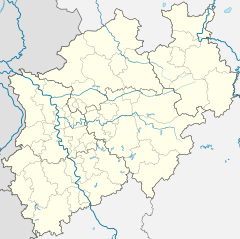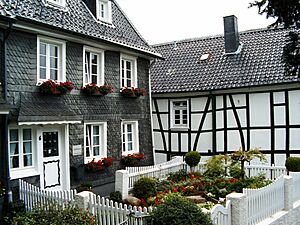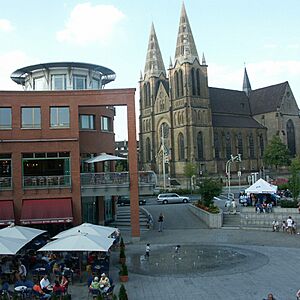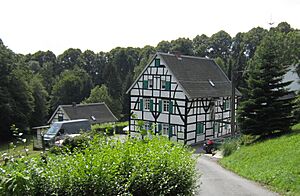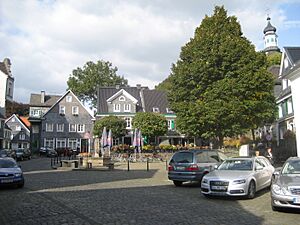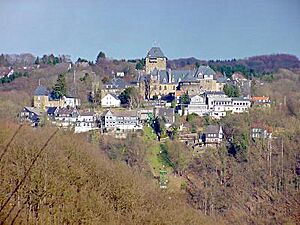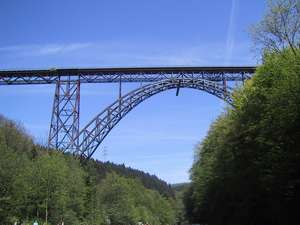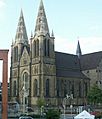Solingen facts for kids
Quick facts for kids
Solingen
Solich (Limburgish)
|
|||
|---|---|---|---|
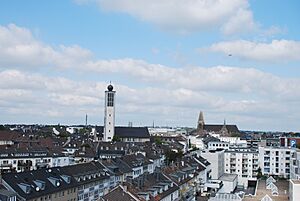
Solingen-Mitte
|
|||
|
|||
| Country | Germany | ||
| State | North Rhine-Westphalia | ||
| Admin. region | Düsseldorf | ||
| District | Urban district | ||
| Area | |||
| • Total | 89.45 km2 (34.54 sq mi) | ||
| Highest elevation | 276 m (906 ft) | ||
| Lowest elevation | 53 m (174 ft) | ||
| Population
(2022-12-31)
|
|||
| • Total | 160,643 | ||
| • Density | 1,795.90/km2 (4,651.35/sq mi) | ||
| Time zone | UTC+01:00 (CET) | ||
| • Summer (DST) | UTC+02:00 (CEST) | ||
| Postal codes |
42601-42719
|
||
| Dialling codes | 0212 | ||
| Vehicle registration | SG | ||
| Website | www.solingen.de | ||
Solingen is a city in North Rhine-Westphalia, Germany. It is located about 25 kilometers (15 miles) east of Düsseldorf. The city is on the northern edge of the Bergisches Land region, south of the Ruhr area. After Wuppertal, Solingen is the second-largest city in the Bergisches Land. It is also part of the regional authority of the Rhineland.
Solingen is famous for making high-quality blades. It is often called the "City of Blades." For a long time, people have known Solingen for its excellent swords, knives, scissors, and razors. Many well-known companies that make these items are located here.
In the Middle Ages, the people who made swords in Solingen helped design the city's coat of arms. Later, in the 1600s, some swordsmiths from Solingen moved to England. They took their secret sword-making skills with them.
Contents
Geography and Nature
Solingen is located southwest of Wuppertal in the Bergisches Land area. The city covers an area of about 89.45 square kilometers (34.54 square miles). About half of this land is used for farming, gardening, or forests.
The city's border is 62 kilometers (39 miles) long. Solingen stretches 15.6 kilometers (9.7 miles) from east to west and 11.7 kilometers (7.3 miles) from north to south. The Wupper river, which flows into the Rhine, runs through the city for 26 kilometers (16 miles). The highest point in Solingen is 276 meters (906 feet) high. It is in the northern part of Gräfrath at the Light Tower. The lowest point is 53 meters (174 feet) high in the southwest.
Neighboring Cities
Solingen shares its borders with several other cities and towns. These include:
City Parts
Solingen is divided into five main parts called boroughs (Stadtbezirke). Each borough has its own local council. These councils are made up of 13 or 15 representatives. They are chosen by the people living in the borough every five years. These councils help manage many important local matters.
The five city boroughs are:
- Gräfrath
- Wald (Solingen)
- (Solingen-)Mitte
- Ohligs/Aufderhöhe/Merscheid
- Höhscheid/Burg
Some of these boroughs, like Ohligs/Aufderhöhe/Merscheid and Höhscheid/Burg, are further divided into smaller sections. These sections used to be separate towns. They are still used for statistics and planning, but they no longer have their own governments.
The city also has many neighborhoods, each with its own name. Their exact borders are not always clearly defined.
History of Solingen
Early Times
Solingen was first mentioned in a written record in 1067. Back then, a writer called the area "Solonchon." Over time, the name changed to "Solengen," "Solungen," and "Soleggen." The name "Solingen" has been used since the late 1300s or early 1400s.
Archaeologists have found old blacksmiths' workshops around the town. These date back more than 2,000 years! This shows that Solingen was a major center for blacksmithing in Northern Europe. Swords made in Solingen were highly valued. They have even been found in places like the Anglo-Saxon kingdoms in the British Isles. People traded these high-quality weapons all over Europe. Today, Solingen is still known as Germany's main city for knives and blades.
For many centuries, Solingen was a small village. But in the 1400s, it became a fortified town, meaning it had defenses like walls.
Challenges and Changes
Between 1614 and 1619, a terrible disease called the plague affected Solingen. About 1,800 people died during this time. Later, during the Thirty Years' War, Solingen faced many attacks and was plundered. Burg Castle was also destroyed during this period.
In the early 1900s, Ohligs, a nearby town, was known for making cutlery and household hardware. It also had iron factories and flour mills. Other businesses included brewing, dyeing, weaving, and making bricks. In 1929, Ohligs became part of Solingen.
During World War II, the old town center of Solingen was heavily damaged by bombing raids in 1944. Because of this, there are not many buildings left from before the war in the city center. After the war, from 1945 to 1949, Solingen was part of the British occupation zone.
Rebuilding the old town began in 1949. A new Protestant church was built in 1954. The damaged towers of the Catholic church of St. Clemens were also rebuilt. By the end of the 1970s, many new homes were built, and the city's population grew. Solingen also improved its public services. A theater and concert hall opened in 1963. A new motorway, the Viehbachtalstraße, was built through the city in the late 1970s. In 1975, the city grew again when the town of Burg an der Wupper joined Solingen.
Since the year 2000, Solingen has changed a lot with new city development projects. For example, a new bike path called Korkenzieherstrasse was created. An old hotel and shopping area were taken down to build a new shopping center in Solingen-Mitte. Also, the old main train station in Solingen-Mitte closed. On December 10, 2006, Ohligs station officially became the new Solingen central station.
Population Growth
Solingen's population grew a lot between 1880 and 1890. This was because the town of Dorp became part of Solingen in 1889. At that time, the population reached 36,000 people. The population got another big boost on August 1, 1929. This is when Ohligs, Wald, Höhscheid, and Gräfrath joined the city. This made Solingen's population go over 100,000. This meant Solingen was now considered a "large city" (Großstadt). The number of people living in Solingen was highest in 1971, with 177,899 residents. In 2006, the population was 163,263.
The tables below show how Solingen's population has changed over time.
| Year | Population |
|---|---|
| 1747 | about 2,000 |
| 1804 | about 2,871 |
| 1818 | about 4,000 |
| 3 December 1846 | 6,127 |
| 3 December 1861 | 10,100 |
| 3 December 1864 | 11,800 |
| 3 December 1867 | 13,000 |
| 1 December 1871 | 14,040 |
| 1 December 1875 | 15,142 |
| 1 December 1880 | 16,900 |
| 1 December 1885 | 18,641 |
| 1 December 1890 | 36,540 |
| 2 December 1895 | 40,843 |
| 1 December 1900 | 45,260 |
| 1 December 1905 | 49,018 |
| 1 December 1910 | 50,536 |
| 1 December 1916 | 45,720 |
| Year | Population |
|---|---|
| 5 December 1917 | 47,459 |
| 8 October 1919 | 48,912 |
| 16 June 1925 | 52,002 |
| 16 June 1933 | 140,162 |
| 17 May 1939 | 140,466 |
| 31 December 1945 | 129,440 |
| 29 October 1946 | 133,001 |
| 13 September 1950 | 147,845 |
| 25 September 1956 | 161,353 |
| 6 June 1961 | 169,930 |
| 31 December 1965 | 175,634 |
| 27 May 1970 | 176,420 |
| 31 December 1975 | 171,810 |
| 31 December 1980 | 166,085 |
| 31 December 1985 | 157,923 |
| 25 May 1987 | 159,103 |
| 31 December 1990 | 165,401 |
| Year | Population |
|---|---|
| 31 December 1995 | 165,735 |
| 31 December 2000 | 164,973 |
| 31 December 2005 | 163,581 |
| 31 December 2006 | 162,948 |
| 31 December 2007 | 162,575 |
| 31 December 2008 | 161,779 |
| 30 April 2009 | 160,242 |
| 9 May 2011 | 155,265 |
| 31 December 2012 | 155,316 |
In 2012, about 30.9% of the people living in Solingen had family roots from other countries.
| Nationality | Population (31 December 2022) |
|---|---|
| 6,130 | |
| 5,945 | |
| 1,854 | |
| 1,660 | |
| 1,573 | |
| 1,370 | |
| 1,227 | |
| 1,093 | |
| 971 | |
| 945 |
Getting Around Solingen
Train Travel
Solingen Hauptbahnhof (main station) is served by different train lines. The Rhine-Ruhr S-Bahn line S1 connects Solingen to Düsseldorf and Düsseldorf Airport Station. The S-Bahn line S7 links Solingen to Wuppertal. This line also stops at Solingen Mitte (the station closest to the city center) and Solingen-Grünewald.
The Rhein-Wupper-Bahn (RB 48) goes to Bonn-Mehlem, passing through Opladen and Cologne. Since December 2022, an extra line, RE47, runs from Remscheid to Düsseldorf via Solingen.
| Station | Lines served | Destinations | Notes |
|---|---|---|---|
| Solingen Hauptbahnhof | Dortmund – Solingen – Mannheim – Munich (InterCity Express) | You can switch to Obus Solingen (trolleybus) lines 681, 682 here. | |
| Hannover – Solingen – Cologne – Mannheim – Basel (InterCity Express) | |||
| Dortmund – Solingen – Frankfurt – Vienna (InterCity Express) | |||
| Hamburg – Solingen – Cologne – Frankfurt (InterCity) | |||
| Leipzig – Hannover – Solingen – Cologne | |||
| Krefeld – Cologne – Solingen – Wuppertal – Hagen – Hamm – Münster – Rheine (RegionalExpress) | |||
| Düsseldorf – Solingen – Remscheid – Remscheid Lennep | |||
| Wuppertal-Oberbarmen – Solingen – Cologne – Bonn-Mehlem (RegionalBahn) | |||
| S-Bahn to Dortmund | |||
| S-Bahn to Wuppertal via Remscheid | |||
| Solingen Mitte | This is the closest station to the historic city center. You can switch to trolleybus lines 681, 683, 684, 686 here. | ||
| Solingen Grünewald | You can switch to trolleybus line 682 here. | ||
| Solingen Vogelpark | |||
| Solingen Schaberg | |||
Trolleybuses
Solingen has a special type of bus system called a trolleybus network. These buses run on electricity from overhead wires. Solingen is one of only three cities in Germany that still use trolleybuses.
Airports Nearby
The closest airports to Solingen are Düsseldorf Airport and Cologne Bonn Airport. You can reach both airports by train from Solingen-Hauptbahnhof. Other airports that are easy to get to include Frankfurt Airport and Dortmund Airport.
Religion in Solingen
Christianity
From its very beginning, Solingen has been part of the Roman Catholic Archdiocese of Cologne. Even though the Protestant Reformation slowly grew in the city, most people stayed Catholic for a while. The Catholic community got a new church building in 1701. In 1827, Solingen became the center of its own deanery within the Archdiocese of Cologne.
The Reformation started to take hold in Solingen in the late 1500s. A reformed church was set up in 1590. The city's main church became reformed in 1649. Lutherans also started to appear in Solingen in the early 1600s, and a Lutheran church group was formed in 1635. In 1672, the different religious groups in the city agreed on how they would live together.
Today, about 34% of Solingen's population belongs to Protestant churches. Around 26% belong to Catholic churches. Other Christian groups in Solingen include Greek Orthodox, Evangelical Free (like Baptists), Methodist, Seventh-day Adventist, Pentecostal, and Salvation Army. The Church of Jesus Christ of Latter-day Saints, Jehovah's Witnesses, and the New Apostolic Church also have groups in Solingen.
Islam
Many Turkish people who have moved to Solingen are Muslim. They have several mosques and places of worship in the city. These include:
- DITIB Solingen Wald
- Mesjid Nur
- Islamische Gemeinde Milli Görüs (IGMG)
- Islamisches Kulturzentrum
- Solingen Camii (Verband der Islamischen Kulturzentren, VIKZ)
Places to See
- Burg Castle: This is the castle that belonged to the counts of Berg.
- Müngsten Bridge: This is a railway bridge that connects Solingen with the nearby town of Remscheid. It is 107 meters (351 feet) above the ground, making it the highest railway bridge in Germany. It was built in 1897.
- Klosterkirche: This used to be a convent church and was built in 1690.
Museums to Visit
- Rhineland Industrial Museum Hendrichs Drop Forge: This museum shows how things were made in factories.
- German Blade Museum: Here, you can see swords and cutlery from different time periods.
- Art Museum Solingen (Museum of Art)
- Museum Plagiarius: This museum shows original products next to fake copies of them. It helps people understand how important it is to protect original ideas.
- Laurel and Hardy Museum: A museum dedicated to the famous comedy duo.
- Zentrum für verfolgte Künste (Center for Persecuted Arts): This center focuses on art that was banned or harmed.
Parks and Gardens
- Botanischer Garten Solingen: A beautiful botanical garden where you can see many different plants.
- Bärenloch
- Walder Stadtpark in Solingen-Wald
- Gustav-Coppel-Park
- Süd-Park
- Brückenpark: This park is located beneath the Müngsten Bridge.
Sports in Solingen
American Football
The Solingen Paladins is an American football club. It was started in 2006.
Baseball
The Solingen Alligators are a baseball and softball club. The club began in 1991. Their main men's team moved up to the top division of the Baseball Bundesliga in 2003. They have played there every season since then. They won the league championship in 2006 and 2014. The club has over 250 members.
Chess
The Schachgesellschaft Solingen e.V. 1868 is famous for its chess team. They play in the Schachbundesliga, which is the highest level of chess in Germany. This club is the most successful in German chess history. They have won a record 12 national titles and two European cups.
Handball
In handball, Solingen's most successful team is Bergischer HC. They play in the top-tier Handball-Bundesliga. They were promoted to this league for the second time in 2013. The club represents the entire Bergisches Land region. The team plays its home games at both Solingen's Klingenhalle and Wuppertal's Uni-Halle.
Sister Cities
Solingen has special partnerships with other cities around the world. These are called twin towns or sister cities. They work together to share culture and ideas.
 Gouda, Netherlands (since 1957)
Gouda, Netherlands (since 1957) Chalon-sur-Saône, France (since 1960)
Chalon-sur-Saône, France (since 1960) Blyth, England, United Kingdom (since 1962)
Blyth, England, United Kingdom (since 1962) Jinotega, Nicaragua (since 1985)
Jinotega, Nicaragua (since 1985) Ness Ziona, Israel (since 1986)
Ness Ziona, Israel (since 1986) Thiès, Senegal (since 1990)
Thiès, Senegal (since 1990) Aue, Germany (since 1990)
Aue, Germany (since 1990)
Since 1990, Solingen also supports Złotoryja County in Poland.
Famous People from Solingen
- Johann Wilhelm Meigen (1764–1845), an expert on insects.
- Albert Bierstadt (1830–1902), a famous landscape painter.
- Ernst Otto Beckmann (1853–1923), a chemist.
- Walter Scheel (1919–2016), a politician who became the 4th President of Germany.
- Pina Bausch (1940–2009), a well-known dancer and choreographer.
- Richard David Precht (born 1964), a philosopher and writer.
- Veronica Ferres (born 1965), an actress.
- Sebastian Thrun (born 1967), an entrepreneur and computer scientist.
- Jens Weidmann (born 1968), a former president of the German central bank.
- Christoph Kramer (born 1991), a footballer.
The people who started the Studebaker Brothers Manufacturing Company, which later became the car company Studebaker, came from this region. Their ancestors were bladesmiths who moved to America in 1736.
Images for kids
See also
 In Spanish: Solingen para niños
In Spanish: Solingen para niños





